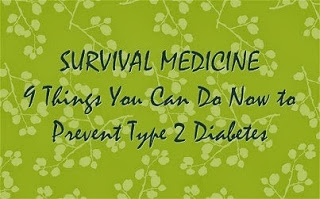Gaye Levy
When it comes to dealing with medical issues in a survival situation, one of the most frequent questions I get has to do with treating diabetes when drugs are no longer widely available. Since I am not a medical or a healthcare professional, I have always had to beg off answering, because I simply do not have the knowledge to address this topic with any degree of credibility. Because of this, I was delighted to see the issue of diabetes in a survival situation finally addressed by an experienced physician who is well versed in emergency and medical preparedness.
Doctor Joe Alton, who is also known as Dr. Bones, has written a series of articles that not only describe diabetes and its causes and symptoms, but also shares some steps you can take now to prevent getting this affliction in the first place.
According to Joe:
Diabetes is the cause of death or a contributing factor in close to 100,000 deaths each year in the U.S. As many who have type 2 diabetes are unaware of it, there are likely huge numbers of “pre-diabetics” who may begin to have medical issues in the next decade. This means that millions will be dependent on oral medications like Metformin or insulin injections to stay healthy. In the event of a true disaster, this translates into big problems when the pharmaceuticals run out.
In my view, the prudent thing to do is take steps preventive steps to stay healthy now. Clearly, preventing the onset of type 2 diabetes is one of those steps. Dr. Bones suggest the following 9 things you can do now to prevent type 2 diabetes.
- Get to a normal weight
- Change your diet
- Get active
- Quit smoking
- Drink Alcohol in moderation
- Consume Cinnamon
- Drink Tea
- Intake Vitamin D and Calcium
- Eat Barley
Most of these suggestions are common sense lifestyle choices that can be adopted by just about anyone. With Joe’s permission, today I share with you part 3 of his 4 part series on diabetes and survival.
*****
9 Things You Can Do Now to Prevent Type 2 Diabetes
Type 2 Diabetes (known in the past as adult-onset or non-insulin dependent diabetes) is usually the result of your body’s resistance to pancreatic insulin. Insulin is required to move sugar (glucose) into cells; there, it is stored and later used to produce energy for the body.
In type 1 diabetes, there is the failure or death of the pancreatic cells that make insulin. This causes an absolute deficiency of the hormone. In type 2, there is insulin produced; your body, however, chooses to resist its effects, resulting in elevated sugar levels (“hyperglycemia”). Over time, hyperglycemia causes damage to various organs, including the heart, kidneys, eyes, and nerves.
 If there is a good example for an epidemic disease, type 2 diabetes would be it. In the U.S., there are 24 million diabetes, the grand majority of which are type 2. This number should more than double by the year 2050, both in the U.S. and worldwide, afflicting more than half a billion people.
If there is a good example for an epidemic disease, type 2 diabetes would be it. In the U.S., there are 24 million diabetes, the grand majority of which are type 2. This number should more than double by the year 2050, both in the U.S. and worldwide, afflicting more than half a billion people.
Diabetes is the cause of death or a contributing factor in close to 100,000 deaths each year in the U.S. As many who have type 2 diabetes are unaware of it, there are likely huge numbers of “pre-diabetics” who may begin to have medical issues in the next decade. This means that millions will be dependent on oral medications like Metformin or insulin injections to stay healthy. In the event of a true disaster, this translates into big problems when the pharmaceuticals run out.
Given this disturbing trend, we should formulate a plan of action to nip type 2 diabetes in the bud. Unlike type 1 diabetes, type 2 does have a well-known and accepted preventative strategy. These seek to correct the main risk factors for the disease:
- Obesity (especially around the waist)
- Lack of Exercise
- Poor Nutrition
- Age older than 45 years
- High blood pressure
- Elevated bad cholesterol (LDL), low “good” cholesterol (HDL) and high triglycerides (fats in blood)
- Smoking
- Family history
- Genetic factors
Certain minority groups such as African-Americans, Hispanics, and Native-Americans seem to have higher risk of diabetes. Although genetics, age, and other uncontrollable factors may play a role in type 2 diabetes, they are less important than aspects relating to lifestyle and behavior. You may not be able to change your age (you can try), but you can change your lifestyle.
If you can follow a few simple recommendations, you can decrease your chances of progressing to type 2 diabetes if you are currently pre-diabetic. Also, if you have type 2 diabetes currently, you can prevent the long-term damage to organs that it causes. You may be thinking: “Not another doctor telling me to exercise and live right”.
Well, maybe I am; there are studies, however, that back me up. The landmark study called the Diabetes Prevention Program (DPP) took thousands of people at high risk for type 2 diabetes and placed half of them on a basic diet and exercise program. Over the next few years, the chances of becoming diabetic were 58% lower in those who lost an average of 10 pounds (5% of body weight) and exercised. These results were not flukes; studies from China and Finland achieved the same results.
Another well-known Study took 85,000 female nurses and followed them over a period of 16 years. The risk for development of type 2 diabetes was decreased 90% if the nurse in question:
- Had a normal weight for height and age
- Ate a healthy diet
- Exercised 30 minutes a day
- Didn’t smoke
- Drank around 3 alcoholic beverages a week (!)
So here are some simple recommendations that can help you prevent the progression of type 2 diabetes:
 Get to a normal weight. Obesity is the major cause of type 2 diabetes. You have several times the chance of becoming diabetic if you don’t get to a healthy weight for your height and age. The risk is even higher if you are morbidly obese. You don’t have to lose it all at once; even if you just lose 5% of your current weight, you can drop your risk by half.
Get to a normal weight. Obesity is the major cause of type 2 diabetes. You have several times the chance of becoming diabetic if you don’t get to a healthy weight for your height and age. The risk is even higher if you are morbidly obese. You don’t have to lose it all at once; even if you just lose 5% of your current weight, you can drop your risk by half.
Change your diet. Several adjustments in what you eat can decrease your chances of developing type 2 diabetes:
- Avoid processed foods. In the Nurse’s Health Study, diets rich in whole grains were found to protect against diabetes; processed foods (white bread, white rice, donuts, etc.) caused an increased risk. Scientists looked at the whole grain consumption of over 160,000 women. they found that women who had 2 or 3 servings of whole grains daily had a 30% less chance of type 2 diabetes that those who ate processed foods. Drinks like sodas were particularly bad, causing spikes in blood levels of sugar (glucose). Drink water or unsweetened coffee and tea instead (in moderation).
- Carefully manage the fats in your diet. Polyunsaturated fats found in liquid vegetable oils, nuts, and seeds can help prevent type 2 diabetes. Trans fats, found in many baked goods and fried fast foods, have the opposite effect.
- Pick protein sources that improve your ability to avoid type 2 diabetes. There is evidence that red meat (beef and pork) increases your risk, especially if processed (hot dogs, bacon, deli meats). In the Nurse’s Study, eating 3 ounces of red meat increased the chance of developing type 2 diabetes by 20 per cent. If the red meat was in a processed form, the risk increased by 50 per cent.
Get active. Getting your muscles moving improves their ability to use insulin and absorb sugar. This causes less pressure on insulin-producing cells in the pancreas. You don’t have to run a daily marathon to get this effect. Just a brisk 30 minute walk daily will decrease your chances of developing type 2 diabetes by 30 per cent.
Quit smoking. Surprise! Not really, I’m sure you know that smoking does bad things to just about every organ that is affected by diabetes. Smokers have a 50 per cent higher risk of getting type 2 diabetes, not to mention heart disease, etc., etc.
Drink Alcohol in moderation. Surprise again, this time for real! Moderate amounts of alcohol (up to a drink a day) increases insulin’s efficiency at the cellular level. If you don’t drink at present, though, don’t start: You get more benefit by eating well, exercising, and maintaining a normal weight.
Although the above recommendations are standard ways to prevent type 2 diabetes, some natural substances may have a specific beneficial effect. Consider reducing your diabetic risk with:
Cinnamon. Research suggest that regular intake of cinnamon may help reduce levels of blood glucose and cholesterol.
Tea. Drinking several cups of tea (or perhaps a lesser amount of coffee) may help prevent some type 2 diabetes. Green tea was considered superior to black tea for this purpose.
 Vitamin D and Calcium. A 2006 study found that daily intake of 800 IU of vitamin D and 1200 mg. of Calcium decreased the incidence of type 2 diabetes by 33 per cent.
Vitamin D and Calcium. A 2006 study found that daily intake of 800 IU of vitamin D and 1200 mg. of Calcium decreased the incidence of type 2 diabetes by 33 per cent.
Barley. A study published this year suggests that barley may reduce oxidative stress and inflammation, thereby decreasing the risk of type 2 diabetes.
There are others, but these are mostly related to treatment as opposed to prevention. In the next part of this series, we’ll explore both conventional and alternative options for diabetes in survival settings.
Joe Alton, M.D. aka Dr. Bones the Disaster Doctor
Joe and Amy Alton aka Dr. Bones and Nurse Amy, are the authors of the #1 Amazon Bestseller The Survival Medicine Handbook: A guide for when help is NOT on the way. You will find their articles in Backwoods Home, Survivalist, Self Reliance Illustrated, and Survival Quarterly magazines, and at their website at www.doomandbloom.net.
The Final Word
Writing about medical issues – especially when they do not apply specifically to you or your family – is not the most exciting or the most “sexy” thing to share on a preparedness website. That said, for those willing to take heed of the message of prevention, it is important to bring these issues to the forefront.
I encourage you to visit Joe and his wife Amy’s website at www.doomandbloom.net and to read the first the other articles in this series on dealing with diabetes in a survival situation. Here are the links:
Diabetes and Survival: Part 1
Diabetes and Survival, Part 2: Type 1 Prevention
Diabetes and Survival, Part 3: Type 2 Prevention
Diabetes and Survival: Part 4 Treatment
I would like to thank both Joe and Amy for sharing their medical wisdom with the preparedness community. We are truly blessed to have them as part of our community.
Read other articles by Gaye Levy here.
Enjoy your next adventure through common sense and thoughtful preparation!
Gaye started Backdoor Survival to share her angst and concern about our deteriorating economy and its impact on ordinary, middle-class folks. She also wanted to become a prepper of the highest order and to share her knowledge as she learned it along the way. She considers her sharing of knowledge her way of giving back and as always, we at Activist Post are grateful for her contributions.
If you would like to read more from Gaye Levy, check out her blog at http://www.backdoorsurvival.com/. You can also visit her Facebook page or sign up for updates by email by clicking on Backdoor Survival Updates.



Be the first to comment on "Diabetes and Survival"